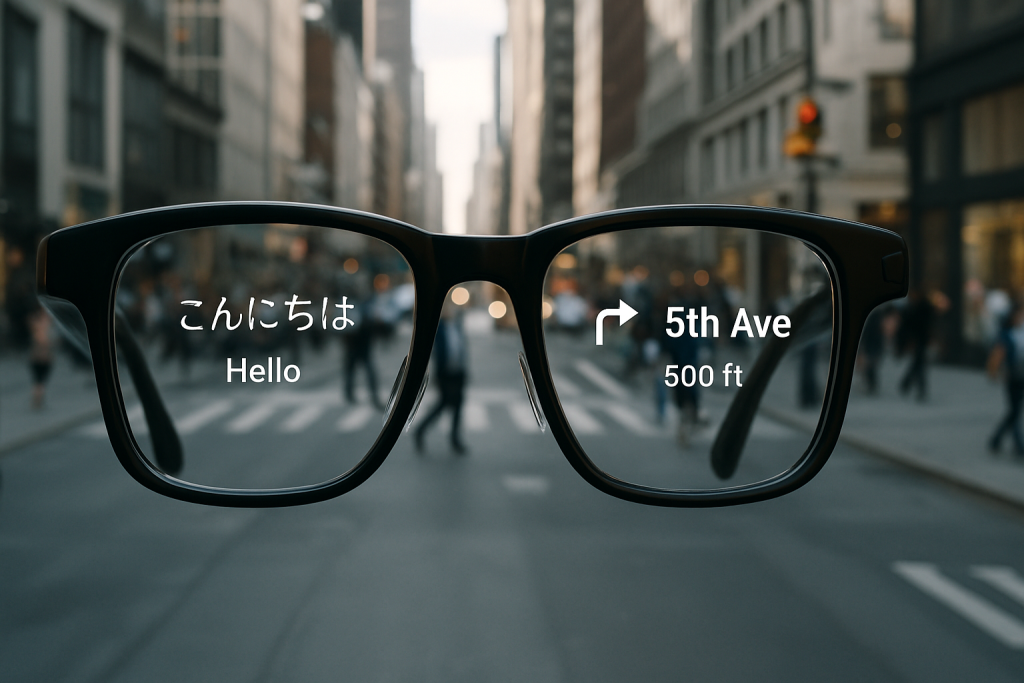September 30th, 2025. Remember that date, folks. Because it might just be the day we officially crossed the Rubicon into a world where AI isn’t just something humming away in a server farm, but a constant companion perched right on your nose. Meta, in collaboration with Ray-Ban, just dropped the Ray-Ban Display smart glasses, and they’re not messing around. Think less Google Glass 2.0 and more Tony Stark’s Jarvis, but in a far more fashionable frame.
For years, we’ve been promised the future of wearable tech. We’ve seen the clunky prototypes, the privacy concerns, and the general sense that strapping a computer to your face just wasn’t…cool. But Meta’s betting that they’ve finally cracked the code. And honestly? They might be right.
The Ray-Ban Display glasses aren’t just about looking good (though, let’s be real, the Ray-Ban pedigree helps). They’re about seamlessly integrating AI into your daily life. Imagine walking down the street and having real-time translations of foreign signs pop up discreetly in your field of vision. Or receiving turn-by-turn navigation without ever glancing at your phone. Or even having Meta’s AI assistant whisper answers to your burning questions directly into your ear. That’s the promise of these glasses. It’s like having a heads-up display for life, powered by the ever-evolving intelligence of AI.
And it’s not just about information. The glasses also pack a punch in the communication department. Taking calls, reviewing photos, and even interacting with social media become effortless. No more fumbling for your phone, no more missing out on the moment because you’re glued to a screen. The Ray-Ban Display glasses aim to keep you connected without disconnecting you from the world around you. Think of it as a digital extension of yourself, always ready to assist, inform, and entertain.
But what truly sets these glasses apart is the suite of features designed to enhance accessibility and user experience. Live captioning for conversations? Genius. A neural wristband for intuitive gesture control? Sign me up. And the real-time AI assistant responses? That’s where things get really interesting.
The Technical Nitty-Gritty
So, how does all this wizardry work? The key is the miniature display embedded within the lens. It’s subtle, unobtrusive, and projects information directly into the user’s field of vision without blocking their view of the real world. Think of it as a very sophisticated version of the augmented reality overlays we’ve seen in games like Pokemon Go, but instead of catching Pikachus, you’re catching vital information and seamless connectivity.
The neural wristband is another piece of the puzzle. It allows for gesture-based control of the glasses, letting you navigate menus, answer calls, and interact with the AI assistant with simple hand movements. It’s a clever way to avoid the awkwardness of voice commands in public and offers a more intuitive and natural user experience. It’s like having a tiny, invisible remote control for your life.
Of course, the real magic lies in the AI itself. Meta’s AI assistant is constantly learning and evolving, providing increasingly personalized and relevant information. It can answer questions, provide recommendations, and even anticipate your needs before you even realize them. It’s like having a super-smart, always-on personal assistant who lives on your face.
The Price of Progress
Now, let’s talk about the elephant in the room: the price. At $799, the Ray-Ban Display glasses aren’t exactly cheap. But Meta’s betting that the combination of style, functionality, and AI integration will be enough to entice early adopters and tech enthusiasts. Think of it as the price of admission to the next generation of wearable technology. It’s a hefty investment, but one that could potentially transform the way we interact with the world.
And it’s not just Meta playing in this space. The unveiling of Gen 2 and Oakley Vanguard smart glasses alongside the Ray-Ban Display shows that the market for AI-powered wearables is heating up. These new models focus on specific niches, like enhanced video recording, fitness tracking, and sports performance analysis, further demonstrating the versatility and potential of this technology.
Who Wins, Who Loses?
The implications of this launch are far-reaching. Obviously, Meta and Ray-Ban stand to gain significantly if the Ray-Ban Display glasses are a success. But the impact extends beyond just these two companies. The entire wearable tech industry could receive a major boost, paving the way for further innovation and adoption. Think of it as the iPhone moment for smart glasses. If it catches on, the floodgates could open.
On the other hand, traditional smartphone manufacturers might feel a slight chill. If smart glasses become a viable alternative to smartphones, it could lead to a gradual decline in smartphone sales. It’s not an immediate threat, but it’s a trend that smartphone companies will need to watch closely.
And then there’s the potential impact on society as a whole. Imagine a world where everyone is walking around with AI-powered glasses, constantly connected and augmented with digital information. It could lead to increased efficiency, productivity, and access to knowledge. But it could also raise concerns about privacy, surveillance, and the potential for digital overload.
Ethical Quandaries and Societal Shifts
Let’s be real, this is where things get a little Black Mirror-esque. The Ray-Ban Display glasses raise some serious ethical questions. How do we ensure that these glasses are used responsibly? How do we protect people’s privacy in a world where everyone is potentially recording and analyzing everything around them? And how do we prevent the glasses from becoming a tool for manipulation and control?
These are not easy questions to answer, and they require careful consideration and open dialogue. We need to establish clear guidelines and regulations to ensure that AI-powered wearables are used for good and not for ill. Otherwise, we risk creating a dystopian future where technology controls us, rather than the other way around.
Furthermore, the constant stream of information provided by the glasses could lead to cognitive overload and decreased attention spans. We need to be mindful of the potential for digital addiction and develop strategies for maintaining a healthy balance between the digital and physical worlds.
The Future is on Your Face (Maybe)
Meta’s Ray-Ban Display smart glasses represent a bold step towards a future where AI is seamlessly integrated into our daily lives. They offer a glimpse of a world where technology is not just a tool, but a constant companion, always ready to assist, inform, and entertain. Whether that future is a utopia or a dystopia remains to be seen. But one thing is certain: the Ray-Ban Display glasses have sparked a conversation about the potential and the perils of AI-powered wearables. And that conversation is only just beginning.
Discover more from Just Buzz
Subscribe to get the latest posts sent to your email.


